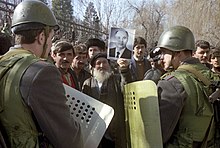Riots in Dushanbe in February 1990
The February 1990 riots in Dushanbe were a series of anti-Armenian and anti -government riots and violent protests in Dushanbe , the capital of the Tajik SSR . They were a first sign of the Tajik civil war from 1991 onwards. 22 people were killed and 565 injured in the course of the unrest.
procedure
The background to the unrest was the brief settlement of some Armenian refugees from Azerbaijan in Tajikistan. After several violent anti-Armenian riots in Azerbaijan (the pogrom in Sumgait , the pogrom in Kirovabad , and the pogrom in Baku ), the Soviet government supported the resettlement of a total of 39 Armenians with relatives in Dushanbe .
At that time there was a shortage of housing in Dushanbe, which is why the reception of refugees was negatively received by the population. Rumors soon spread that the Soviet government was planning to relocate several thousand Armenians to Tajikistan. In fact, the Armenians had only lived with relatives in Dushanbe for a short time and had already left Tajikistan for Armenia. In addition, there was a general dissatisfaction with the Soviet Union in general among large parts of the population, which was already showing signs of disintegration in early 1990.
Although Kachar Makkamov , the then First Secretary of the CPSU in Tajikistan, declared that there were no permanent resettlements of Armenians, this was rejected by most of the demonstrators.

The first major protests took place on February 11, when thousands of demonstrators gathered in front of government buildings. The protesters failed to calm down. The next day the protests intensified, demonstrators chanting slogans like “Down with Machkamov!” Or “Down with the Armenians!”. Nationalist movements also mobilized their supporters, so that the mood was further heated. Shops were set on fire in the evening and a state of emergency was finally declared.
On February 13, all public institutions ceased operations and almost all shops were closed. Violent demonstrators also targeted Armenians and members of the Russian-speaking population groups, including Russians, Ukrainians , Soviet Koreans , Russian Germans , Tatars and Jews. Tajik women in Western clothing were also sometimes exposed to open hostility.
The riots could only be ended by the Red Army , whose help Kachar Machkamov had asked. On February 14, Makkamov and Prime Minister Esatollo Chajejew resigned. A curfew was temporarily imposed and 5,000 soldiers were deployed to calm the situation. Large demonstrations took place a few days later. A total of 22 people were killed and 565 injured.
See also
Individual evidence
- ↑ Ray Takeyh, Nikolas K. Gvosdev: The Receding Shadow of the Prophet: The Rise and Fall of Radical Political Islam. P. 126 ( limited preview in Google Book search)
- ↑ Donald L. Horowitz: The Deadly Ethnic Riot. University of California Press. 2002, p. 74, ISBN 0-520-23642-4 ( limited preview in Google book search).
- ^ Edward Allworth: Central Asia, 130 Years of Russian Dominance. Duke University Press, 1994, ISBN 978-0-8223-1521-6 , p. 587 ( limited preview in Google Book Search)
- ↑ Новости и события. (No longer available online.) In: centrasia.ru. November 9, 2008, archived from the original on June 30, 2009 ; Retrieved January 9, 2015 (Russian). Info: The archive link was inserted automatically and has not yet been checked. Please check the original and archive link according to the instructions and then remove this notice.
